Operation: Stuttgart
Date: 28/29th July 1944 (Friday/Saturday)
Unit: No. 625 Squadron
Type: Lancaster III
Serial: LM546
Code: CF-O
Base: RAF Kelstern, Lincolnshire
Location: Esslingen, Germany
Pilot: F/O. Frank Collett 174772 RAFVR PoW No: 6490 Camp: Stalag Luft Sagan and Belaria
Fl/Eng: Fl/Sgt. Norman Jones 2209235 RAFVR PoW No: 461 Camp: Stalag Luft Bankau
Nav: F/O. Joe Stephenson 152947 RAFVR PoW No: 6964 Camp: Stalag Luft Sagan and Belaria
Air/Bmr: F/O. William R. Lott 152143 RAFVR PoW No: 6952 Camp: Stalag Luft Sagan and Belaria
W/Op/Air/Gnr: Sgt. Ernie Evison 1601354 RAFVR PoW No: 515 Camp: Stalag Luft Bankau
Air/Gnr: Sgt. Lawrence Naylor 2206023 RAFVR PoW No: 476 Camp: Stalag Luft Bankau
Air/Gnr: Fl/Sgt. 'Jock' William Alexander Peterkin (later DFM) 636801 RAFVR PoW No: 480 Camp: Stalag Luft Bankau
Page information gathered and submitted by Jack Albrecht and Nic Lewis for Aircrew Remembered - February 2018 - for full credits of contributors please see foot of page.
REASON FOR LOSS:
This crew was posted to RAF Kelstern on the 20th May 1944 from Base 11 to start their tour of operations. P/O. Collett did not have the luxury of a ‘second dickie’ trip to adjust to the grim reality of night combat over Occupied Europe. Their first mission was to Tergnier on the 31st May 1944 aboard ME594. This operation and the next eighteen were relatively uneventful. These included the so called milk-runs to Achères and Vierzon which saw the loss of three and four Squadron crews respectively. They were lucky to thread the needle, making Base intact. Operation No. 7 to Achères proved the exception with a tangential encounter with a night fighter that resulted in the rear gunner, Fl/Sgt. Jock Peterkin, being awarded the Distinguished Flying Medal. ( Editor's note to citation at the end of the article). The crew flew as a unit with the exception of their seventh trip to Gelsenkirchen, when Fl/Lt. A. Flett DFC replaced an incapacitated F/O. J. Stephenson as navigator. Their 19th and 20th missions were to Stuttgart on the 25th and then on the 28th July 1944. They would not get a chance to be third time lucky.
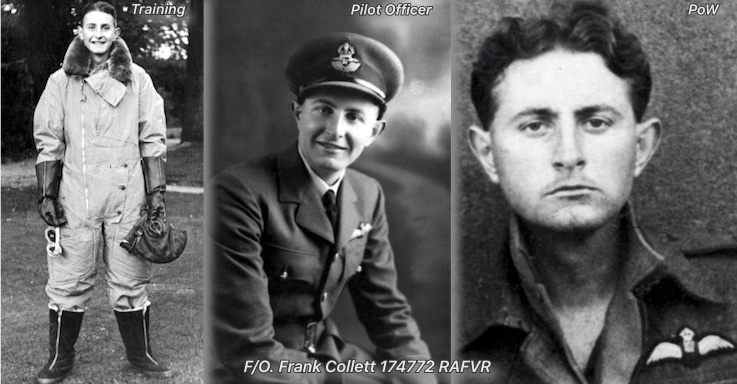
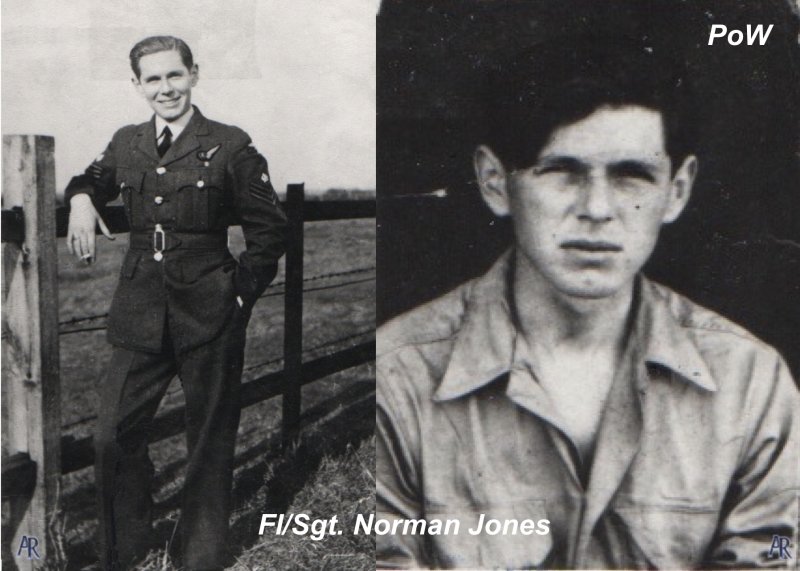
Fl/Sgt. Norman Jones on leave (left) and PoW photograph (right) (Credit: Nigel Jones)
The Squadron ORB notes:
28.7.44 Operations: 17 aircraft were detailed for this Operation, the target again being Stuttgart. A fairly heavy bomb load was carried, and many explosions and fires occurred in the target area. A fair amount of flak was experienced over the target and two of our aircraft failed to return from this Operation. One of the aircraft’s Captain - P/O. (A/F/O) Tuck (1) was on his last operational sortie of his first tour, and his loss was greatly felt by all the Squadron.
28.7.44 Lancaster III P/O. Collett and crew Up 21:19 Down - Stuttgart. Failed to return - no news after take off.
(Y - LM 546)
Summary of Events Kelstern:
July 28/29 Operations: 17 aircraft of 625 Squadron were detailed for an attack on Stuttgart, and all took off, four of these sorties were abortive, two being due to engine failure, one on account of GEE and H2S becoming U/S and one owing of sickness of the Mid Upper Gunner. 10 aircraft bombed the target in cloudy weather, but the marking and bombing appeared to be rather scattered. Two aircraft failed to return - “U” (Pilot, P/O. Tuck) and “O” (Pilot, P/O. Collett).
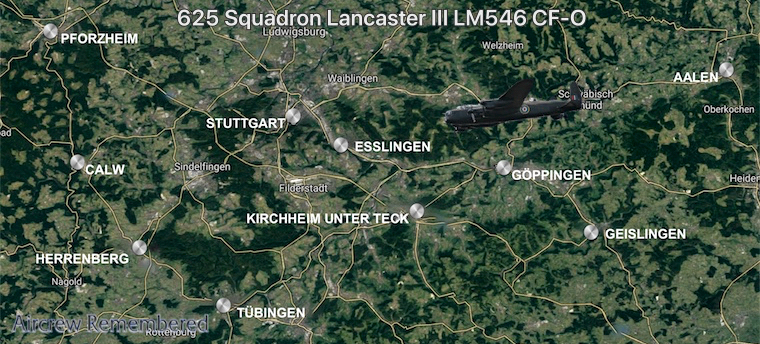
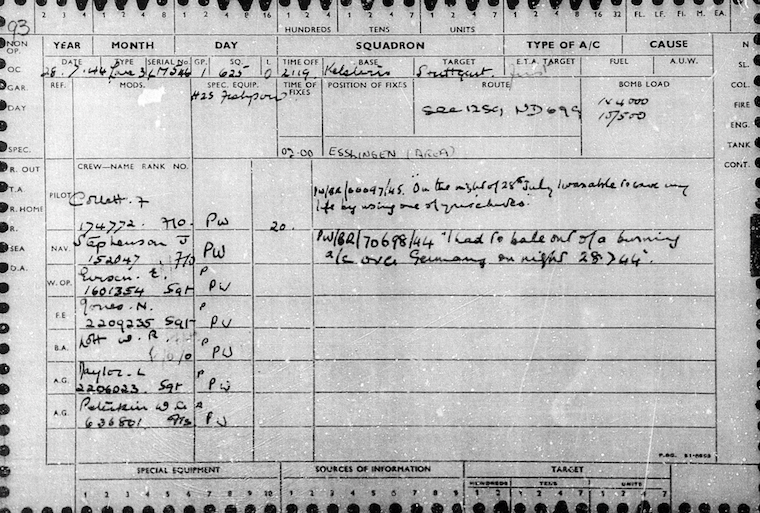
Shown above: Loss card for LM546
The crews account of their seventh and final flight in their favourite ‘kite’, LM546:
John Naylor wrote:
The teleprinter message sent to all groups on 28th July 1944 stated that the 1 Group aircraft, (which included 625 Sqn), were to be in the first wave to bomb. 1 group were scheduled to bomb at 01:45hrs Zulu from a height of 10,000ft. This would take only 2 mins, until the second wave (3 Group a/c with 10 ABC a/c of 1 group) would follow, and then the 3rd wave (100 a/c of 5 Group) followed by the fourth wave (a further 100 a/c of 5 Group). The second wave bombed from 15,000ft, and the 3rd and fourth from 20,000ft.
LM546 was at the tail end of the first wave at 10,000ft, and Norman Jones, the Flight Engineer told me that he was standing in the cockpit with the target (Stuttgart) in sight from about 8-10 miles away. Jock Peterkin, the tail gunner had previously seen a Night Fighter stalking them, and Frank Collet had taken evasive action to try and shake him off. My Father told me that they thought they had when all hell broke loose. He had slipped underneath them in a Messerschmitt ME110 G4 with the upward firing 20mm" Schrager Musik" cannon, and fired into their port wing, stopping the port inner engine. Dad told me he saw the cannon shells come through the wing from his mid-upper turret. The fighter then turned to the starboard wing and fired again, this time setting fire to No. 3 engine, and Dad said that the undercarriage came down on that side with the tyre burning fiercely and the wheel going around!
The flames by now were reaching back to the tailplane, and Frank gave the order to bale out. Those at the mid-rear of the aircraft went out the back door, and the rest out of the front. (Norman had released the front escape hatch in the floor with great difficulty, and helped Frank put parachute on). Frank Collet was the last to leave and told me that every time he let go of the yoke, she started to roll, so his timing to let go and dive through the escape hatch had to be timed exactly! He said the noise was deafening and was akin to being sealed inside a large dustbin with 50 people beating sticks against it!
Amazingly (and unusually), all the crew got out. Dad said when he got to rear door, Jock Peterkin was hesitating, so Dad kicked him out! Dad then said that all the way down on his parachute, he was saying to himself "I hope Jocks Parachute opened"! When he got arrested and taken to the local interrogation centre, the first person he saw was Jock Peterkin, who said to him,"was that your boot up my backside in the fuselage"!
Final Log Book Entry by Larry Naylor - MUG of LM546. (courtesy of son, John Naylor):
Captured by Germans on the 29th July 1944 after baling out of aircraft which was attacked by night fighter. Jumped out ‘chute at approx. 10,000 ft, landed safely just outside target area, wrapped self up in parachute and tried to sleep until dawn - decided to make for Switzerland and started heading due south, decided to chance it and kept to the main road - passed a few inhabitants of nearby village, who gave a casual glance and one who said ‘Guten Morgen’.
Filled with confidence, carried on for miles, passed unnoticed by German soldiers in lorry - eventually came to village where I was recognised by a German ‘Frau’ who immediately yelled for her husband, who came after me, and took me to the local ‘Gendarmerie’.
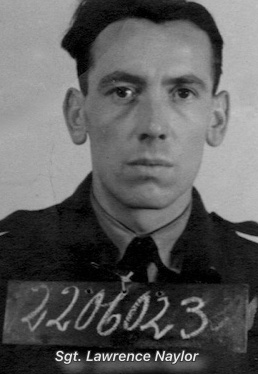
Locked in the local jail for three days and joined by two other members of the Crew.
Then shipped to ‘Dulag Luft’ interrogation centre, ‘not so good’ four or five day solitary confinement, then to Prison Camp in ‘Upper Silesia’ Stalag Luft VII near ‘Breslau’.
Winter of 1944 saw advance of Russian Army, heading our way - Were put on road - and forced marched, with Russians a few days behind.
Marched for days through blinding blizzards and snowstorms, a few nights rest in cowsheds with hardly any food lived on grass and sugar beet.
Thought of escape - but considered not practical - weather bitterly cold - Temperature 20 degrees to 30 degrees below zero.
Lost many boys on roadside - probably frozen to death - after marching 235 kilometres, were put in camp - Frenchmen - Russians - Czechs - Poles - Americans - all prisoners in same camp - Russians treated badly, Food not so good - if any - finally saved by Red Cross parcels
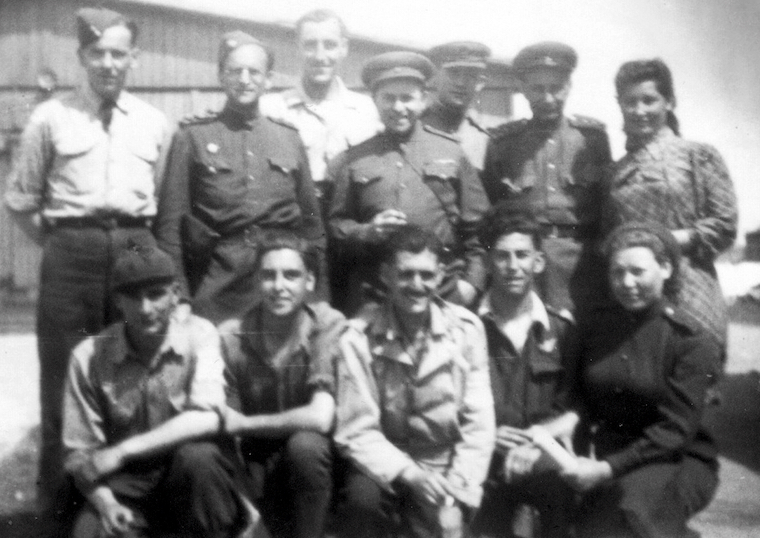 Above: With the Russians in Germany, 1945. Rear row: Larry Naylor,MUG LM546, extreme left, Dick Reeves, WOP LM513, third from left. Front row, Russell Margerison, MUG LM513, second from the left and Ernie Evison, WOP LM546, fourth from the left. (Photo courtesy Boys at War, Russell Margerison, Northway Publications).
Above: With the Russians in Germany, 1945. Rear row: Larry Naylor,MUG LM546, extreme left, Dick Reeves, WOP LM513, third from left. Front row, Russell Margerison, MUG LM513, second from the left and Ernie Evison, WOP LM546, fourth from the left. (Photo courtesy Boys at War, Russell Margerison, Northway Publications).
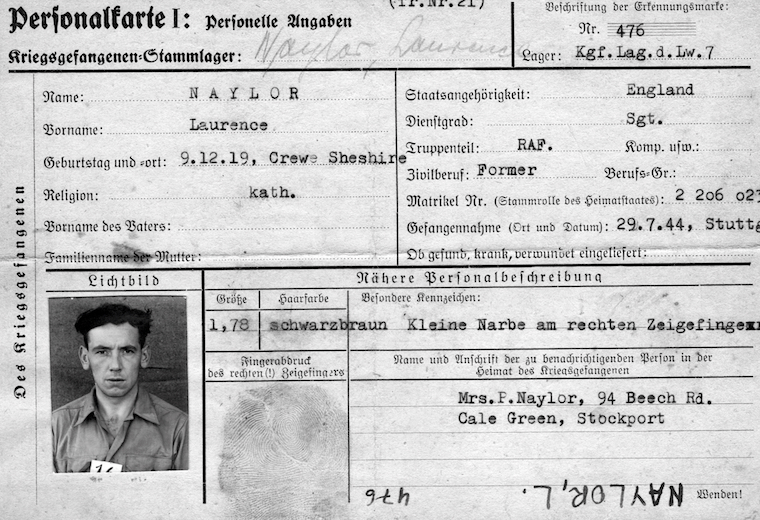
Right: The issued PoW card for Sgt. Lawrence Naylor.
Released by Russians about early May - Not so good - virtually prisoners of Russians - decided to escape - made it with two more boys - lived with German families - Broke into houses - picked up by Russians - put in displaced persons camp - escaped - finally reached ‘Magdeburg’ - held by Russians in Hotel for two weeks and finally sent across the ‘Elbe’ to American Section - and Home via Belgium.
Currently there are 2 theories as to the demise of LM546 CF-O.
Firstly, it has been described as being hit by flak and crashing at around 02:00 in the area of Esslingen, Germany.
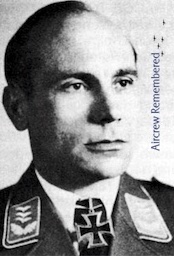
Secondly, John Naylor identified the Luftwaffe pilot, with the later agreement from Dr. Theo Boiten co-author of the 2 volume Night Fighter War Diaries (Rod Mackenzie):
(Right: Oblt. Fritz Lau. See Kracker Archive within this website for further details of this pilot)
Shot down by Oblt. Fritz Lau of 4./NJG1 (from his base at Saint-Trond in Belgium) His 11th claim during the war - Area: 20-25 Km. West of Stuttgart at 01:59 hrs. It is noted that flak 'may' have also hit the Lancaster, but after it had been abandoned.
New publications revising the 2 volume Night Fighter War Diaries are currently under preparation, 1st volume published in February 2018 - a total of, thought to be 11 volumes in the series (Nachtjagd Combat Arhives) to be published over a 3 year period. (Aircrew Remembered subscribing for these in order to update the loss reports on the website)
Amazing, even after some 70 years plus since this aircraft came down, maybe one day absolute confirmation may still one day turn up! That has proven to be the case since we built this website.
P/O Frank Collett was promoted to Flying Officer. He was not decorated for his service to his country or the courage displayed in allowing his crew to bale out before saving his life at the last moment from an aircraft well alight with fuel and bomb load still aboard. Suggested decoration: DFC. It is noteworthy that the loss of LM546 was the only one of the Squadron’s 74 losses that resulted in all seven of the crew surviving as PoWs. Quite a gift by this courageous Captain! It is almost certain that each of the crew had to survive the infamous forced march of January 1945. Remarkable photos of this challenging trek can be viewed on the Lancaster ND571 HW-N page within this site.

Note regarding decorations: The suggested decoration as mentioned within this and other articles rest with the author. Of course we support any recognition for these crews - from both sides! Jack Albrecht has written to HM Government pointing out this and await their positive response. This type of pressure has produced results previously - after all, it has taken 67 years to have the Bomber Command Memorial built in London, England in recognition for the crews who had a 30% chance of surviving a tour of thirty trips! Even now it is supported by charities. The French Government have been awarding 'all' D-Day veterans the Légion d'honneur for the last several years as a way of thanking them secure France's liberation (not available posthumously) A tremendous recognition which, we are proud to say we assisted some of these veterans claim the award.
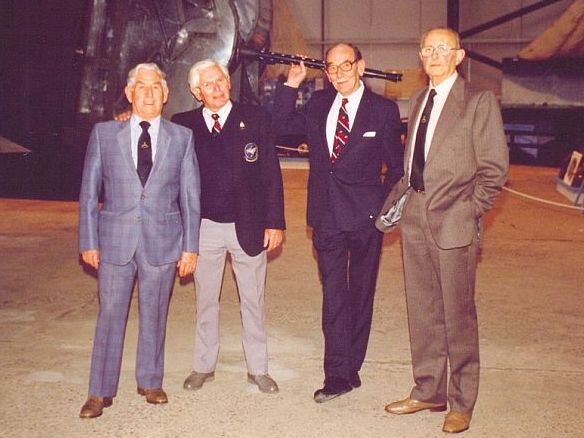
Above: East Kirkby 1991 - L-R: Ernie Evison, Norman Jones, Lawrence Naylor and Frank Collett.
Post War Careers:
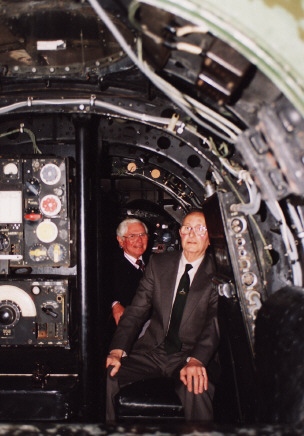
Frank Collett - Left the Royal Air Force in 1946 and then joined Oxfordshire Constabulary that later became Thames Valley Police. After 30 years service, retired with the rank of Superintendent. He subsequently worked for the United States Air Force at Upper Heyford in Oxfordshire as the Housing Officer and retired in his early sixties. Died on the 7th May 1996 at the age of 73.
Larry Naylor - left the Air Force in 1946, but rejoined in 1951! He went on to have a very successful career that included 5 years on the Queens Flight at RAF Benson and tours abroad in Germany, Cyprus and EL Adem, where he met (more than once), Colonel Gadhaffi! He left the RAF in 1974 holding the rank of Warrant Officer, then worked for Rolls Royce before retirement. He died on 2nd August 2004 in his native town of Crewe in Cheshire.
William R. Lott - lived in Cyprus whilst John Naylor was there, but he never managed to make contact. He left messages at the Officers' Mess at Akrotiri where he was an honorary member, but never knew if he received them.William Alexander Peterkin - Flight Sergeant Peterkin left the RAF as a Warrant Officer after the war. He apparently suffered a less than ideal life in later years, and was reportedly living alone at the time of his death in a small flat. It is known that his Daughter contacted Larry Naylor after his death, to ascertain how she could go about obtaining some replacement copies of his medals, as these had apparently gone astray.
London Gazette 14th November 1944
"Flight Sergeant Peterkin is the rear gunner in a Lancaster aircrew who has completed 20 operational sorties on his first tour of operations totalling some 99 hours operational flying. He has participated in attacks on strongly defended targets including Gelsenkirchen and Stuttgart, As rear gunner, he has organised himself and his mid-upper gunner into a most efficient team thus inspiring great confidence in the rest of the crew. Flight Sergeant Peterkin has always been unruffled despite intense opposition and continues his systematic searching for enemy fighters. He has shown a fine offensive spirit and on the night of 9th/10th June 1944, whilst returning from a successful attack on a target at Acheres, Flight Sergeant Peterkin saw a friendly bomber being attacked by an enemy fighter. His skilful co-operation with his pilot enabled him to place his aircraft in a favourable position to attack the enemy fighter. Both he and the mid-upper gunner opened fire on the enemy simultaneously and a steady burst of fire was seen to strike the enemy which burst into flames and a few seconds later was seen to explode on the ground. He has never once relaxed his vigilance and his courage, skill and fine offensive spirit fully merit the award of the Distinguished Flying Medal. His Station Commander remarked: This NCO has proved himself to be an Air Gunner of outstanding merit. Calm and unruffled in danger, he always displays a fine offensive spirit and has won the complete confidence of the other members of his crew. He is strongly recommended for an award of the DFM".
(1) P/O. Harry Humphrey Tuck DFC 176410 RAFVR from Withington, Manchester, England. Choloy War Cemetery. Grave 2A.A.22-23(Joint)
For acts of valour, courage or devotion to duty: Suggested decorations, F/O. Frank Collett 174772 RAFVR - DFC. PoW, eyewitness account.
Burial details:
None - all crew survived as Prisoners of war.
Credits:
Pete Barcroft, grandson of F/O. Frank Collett- photos of F/O. Collett, crew postwar, John Naylor and Theo Boiten. For the photo from the book, 'Boys at War' to Russell Margerison, Northway Publications. Nigel Jones, the son of Fl/Sgt. Jones, for the photographs of his father. References to other sources as shown below.